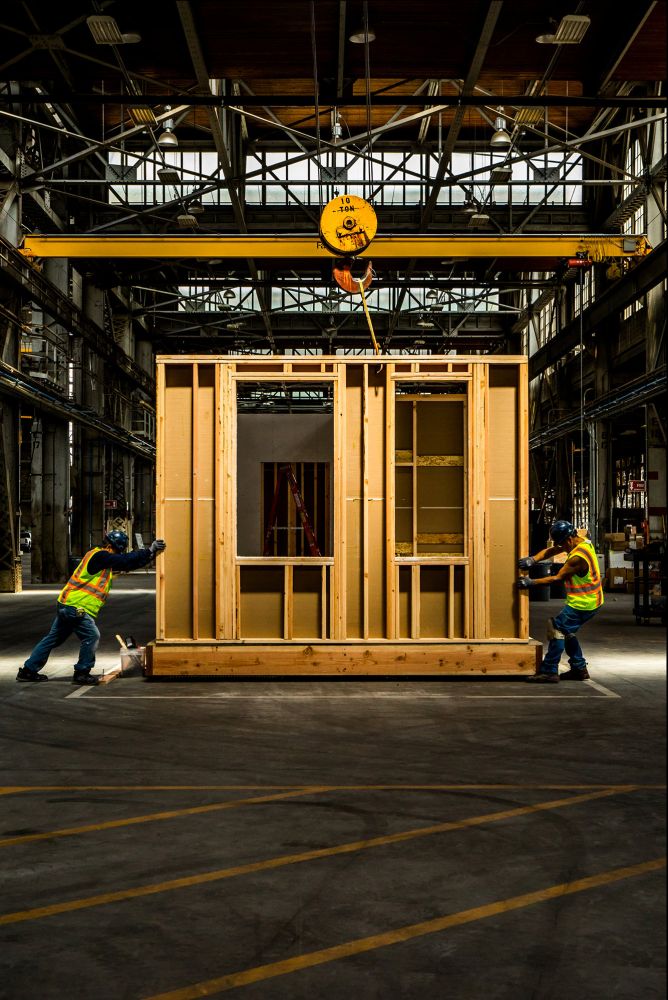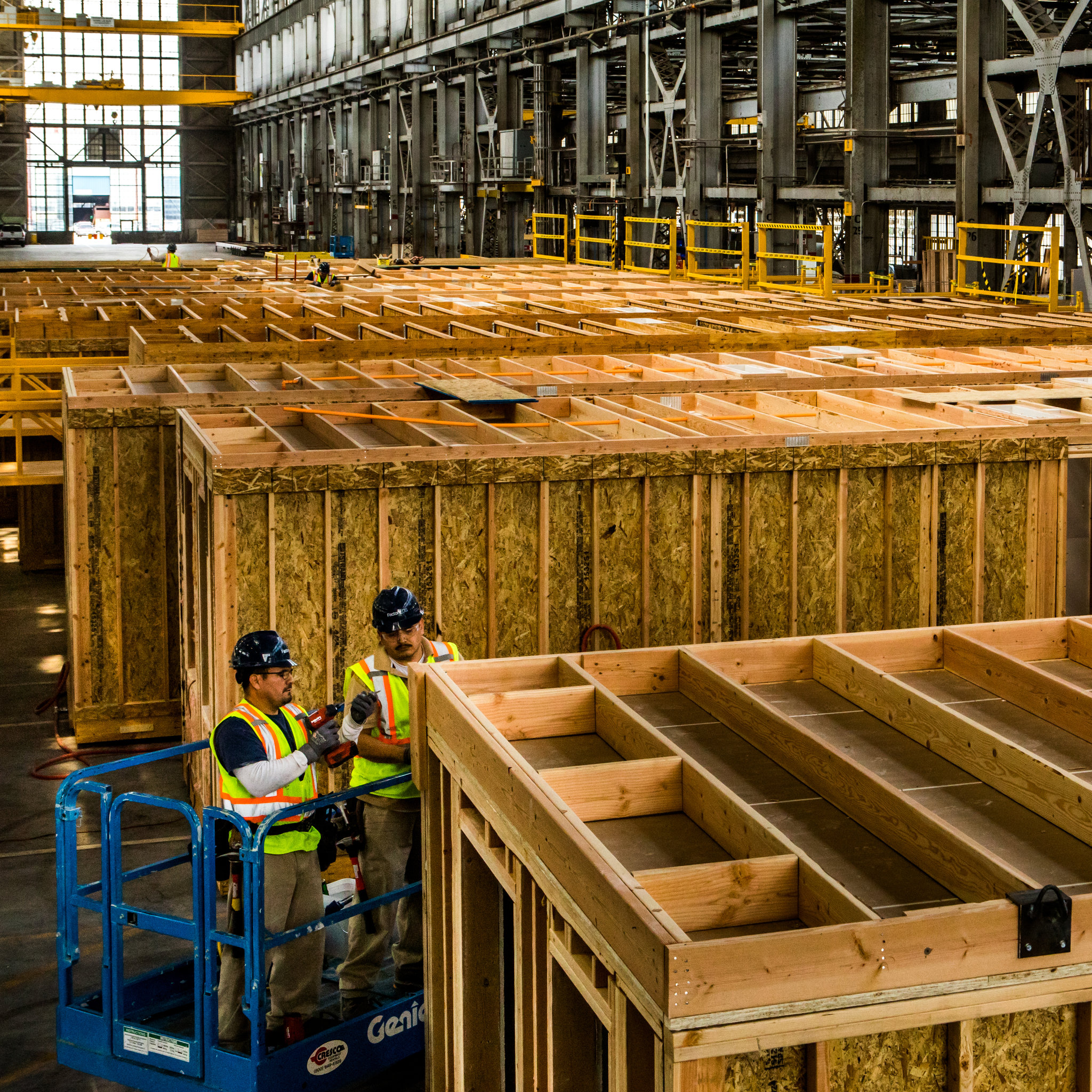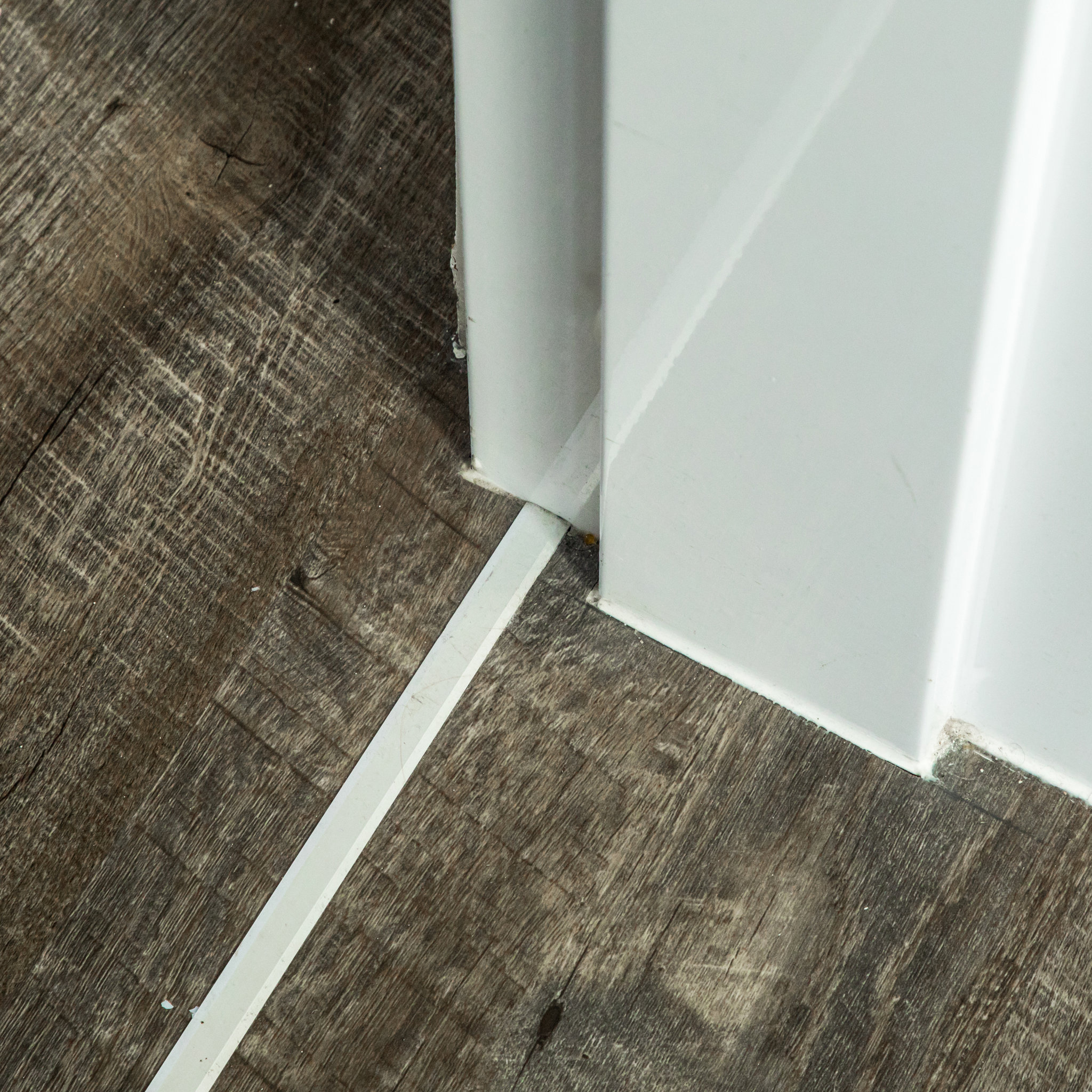Developers are struggling with the problems of residential areas, expanding the concept of the factory assembly of houses to the manufacture of apartment buildings entirely
 In the Factory OS factory in the city of Vallejo (California), modular home segments are assembled at several points, each of which works with a specific part of the assembly process. In the photo - two workers specializing in the manufacture and installation of walls
In the Factory OS factory in the city of Vallejo (California), modular home segments are assembled at several points, each of which works with a specific part of the assembly process. In the photo - two workers specializing in the manufacture and installation of wallsIn California, the real estate crisis is raging due to the lack of affordable housing, which all cities in the state are trying to fight [the mortgage percentage in California
does not exceed 5 / approx. trans.]. Rick Holiday, a long-time developer of the San Francisco Bay Area, believes that one of the answers can be found at the old shipyard in Vallejo, located 40 minutes from San Francisco.
Here, in a warehouse the size of a football field, where workers used to assemble submarines, Holiday recently opened
Factory OS , a factory that manufactures houses. On one side are wood, pipes, tiles, sinks and toilets; from the other there are separate apartments that can be taken by truck to the construction site and sealed, having assembled a house from them in just a few months.
“If we do not build houses differently, no one will have housing,” said Holiday during a recent tour, passing by jobs on the conveyor and piles of building materials - windows, pipes and rolls of pink insulation.
Almost ten years after the
recession crushed the housing construction industry, due to which bankruptcies of contractors and the dismissal of builders who had gone to other jobs, the developers are still far from their previous form. Today, the rate of construction of new apartments and houses
barely exceeds half of the peak in 2006.
 Floors gather on the first conveyor point.
Floors gather on the first conveyor point. Jeff Anderton, a factory OS worker, cuts ceiling profiles, which will then be inserted into modular rooms.
Jeff Anderton, a factory OS worker, cuts ceiling profiles, which will then be inserted into modular rooms. Several baths await their turn
Several baths await their turn At several points, workers concentrate on manufacturing and installing module ceilings.
At several points, workers concentrate on manufacturing and installing module ceilings.The US needs new homes, but the construction industry is not coping with demand. The number of workers employed in housing construction is 23% less than in 2006, and such specialists as plumbers, carpenters and electricians are 17% less. The demand for housing is high, and there are not enough workers, so developers are raising prices, competing for a limited number of contractors.
The cost of construction throughout the country over the past three years has grown by 5% per year, according to the Turner Building Cost Index. In large cities and in California, the cost grew even faster, according to RSMeans, a company that collects construction data. In the Gulf area, property developers say that the cost of construction has increased by 30% over the past three years — so much that even luxury projects are being postponed.
“Everything has reached such a state that it’s impossible to rent or sell apartments in such quantities as to stay afloat,” says Lou Vásquez, founder and manager of Build, a developer from San Francisco.
Rising construction costs occur at the worst possible time for growing cities such as New York, Seattle and San Francisco, which already lack affordable housing, which
is why the
population of homeless people is growing and there are heated debates about growth. and reconstruction of dilapidated buildings. Lawmakers of the state and individual cities tried to approach housing problems by issuing
more subsidies for the construction of affordable housing,
simplifying construction rules and
legalizing the construction of buildings with a large number of floors .
But even if every excessively expensive city suddenly breaks through a thicket of legal restrictions and the
resistance of local residents that impede the construction - and this is unlikely - today's exhausted construction industry will not be able to reach the desired speed. This hits both the rich and the poor, as it increases both the cost of luxury condominiums and the price of affordable housing.
This year, residents of California will vote on the allocation of $ 4 billion subsidy for the construction of affordable housing. In San Francisco, where developers say that the cost of building a single apartment
comes to $ 800,000 , and these subsidies will be enough to build about 5,000 apartments, which will be a drop in the ocean. “The cost has risen so much that it has become impossible to build houses where people would like to live at those prices for the purchase or rent they could afford,” says John
Burns, founder of John Burns Real Estate Consulting.

All this makes developers, such as Holiday, look for cheaper and less labor-intensive construction methods - and investors start investing their money in startups that promise to do just that. Katerra, a home-prefabricated house, formed three years ago and located in Menlo Park,
received $ 1.1 billion in funding . Many other startups, including Blokable from Seattle, Kasita from Austin (Texas) and RAD Urban from Oakland (California), have opened in the last five years.
“The current system is not coping with demand, with the result that people do not have enough opportunities, and it affects the economy,” said Stonley Baptist, co-founder of Urban Us, a Brooklyn investment company that invested in Blokable. "These are rather big problems and rather big markets."
Technologies vary, but usually revolve around simplifying construction thanks to factory-made panels that can be put together, like Ikeev furniture, and modular apartments that can be stacked on top of one another, like LEGO bricks. A third
of the developers
surveyed by FMI reported that they are trying to organize the factory assembly of blanks in one form or another - this is much more than it was in 2010. They are interested in both residential buildings and
hotels , as
medical institutions and industrial companies, and
fast food restaurants .
“This is one of those things that look like a road to quick success, but in reality the path took 10 years and required the hard work of hundreds of people,” said Chris Dzhiatina, general director of BLOX, which builds hospitals with modular components.
Intermediaries and risks
The global construction industry is a $ 10 trillion monster that determines where people live, how to get to work, and what cities look like. It is also
one of the least efficient businesses in the world . Construction efficiency — the number of buildings built in man-hours — has not increased since 1945, according to the McKinsey World Institute. During this time, sectors such as agriculture, manufacturing and retail sales increased their productivity by 1,500%. In other words, while the rest of the economy received the help of cars, computers and robots, the efficiency of developers remains the same as during World War II.
To understand this, consider exactly how houses are built. It all starts with the developer, who actually does not build anything, but only extracts a piece of land and a loan, and also receives permission from the government. At this moment, the money is transferred to the general contractor who has placed a successful construction application, which transfers them to subcontractors who have won auctions for such things as sewerage or sheet metal, which often transfer them to even smaller subcontractors.
Contractors describe this redirection as “intermediary risk.” They mean that although everyone in this chain agreed to build a certain project for a certain amount of money and a certain time, none of them is sure that they can do it so cheaply or quickly as promised. They delegate this risk by paying someone else to do it for them, minus a small commission.

 There are 24 assembly points on the Factory OS pipeline. To station No. 17, where windows are installed, the modules begin to resemble the final product.
There are 24 assembly points on the Factory OS pipeline. To station No. 17, where windows are installed, the modules begin to resemble the final product. Kitchen is almost finished
Kitchen is almost finished Completed studio module, ready for transportation.
Completed studio module, ready for transportation.“Suppose you are the main contractor and your subcontractor agrees to do the work. As soon as you sign a contract, you don’t care how many man-hours are needed to complete the project, as this is not your problem anymore, ”said Randy Miller, director of RAD Urban, describing the course of thought in the process.
The goal of companies building modules in a factory is to turn this model upside down. Instead of throwing off risks, the contractor takes all of them on himself. Instead of transferring the work to subcontractors, they hire their own workers to the factory. “The main contractor says:“ Oh my god, construction is a terrible thing, let me pass on all this risk, ”Miller said. “I say: Oh God, construction is a terrible thing, so I’ll plan everything better and control it.”
The basic concept is not new. In 1624, settlers in Massachusetts built houses from pre-made materials brought from England. This pattern was repeated in Australia, Africa, and India, when the British Empire delivered colonists and structures around the world, according to Prefab Architecture, written by Ryan Smith, a professor at the University of Utah.
Over the next few centuries, new variants of this idea appeared everywhere where people needed to quickly build a lot of housing - during the
California gold rush , after the
great Chicago fire , during the American expansion to the west. At the beginning of the 20th century,
Sears [retail chain manager / approx. trans.] sold tens of thousands of
Sears Modern Homes made up of factory-made parts and panels that the buyer assembled on site.
In this process, the construction industry absorbed such production concepts as a conveyor belt — Levitt & Sons, the pioneer of mass construction, scrapped them. But the idea of making houses in factories has never been implemented entirely and broadly enough to have any significant impact - at least in the United States.
One of the reasons why the United States lagged behind Europe, Australia and Asia - where there are well-functioning companies involved in the manufacture of modular buildings - is the suburban nature of the country's inhabitants, and the huge amount of free land that kept the cost of building individual houses relatively low. Another one is that the construction industry has a very small margin, so it is not customary to invest money in research and development.
Chances of burning out are high, and every serious failure leads to a rejection of the concept. During the construction boom in the mid-2000s, Pulte Homes, one of the largest developers, opened a factory for the production of houses, which was to revolutionize construction. The company closed it in the beginning of the housing crisis in 2007.
 Hungarian builders lower the factory-made kitchen on the construction of a house; 1950s
Hungarian builders lower the factory-made kitchen on the construction of a house; 1950sNow, instead of building separate single-family homes, factory manufacturing companies are concentrating on condominiums and densely built apartments. This is because the construction of individual houses has not yet reached the pre-crisis level, and apartment buildings have recovered quite well. “Our goal is to be able to build a 40-story building in 12 months and at half the cost of traditional construction,” said Miller from RAD Urban.
And yet, although builders can reduce the cost of construction, this does not mean that they can achieve success. Each company puts on the fact that it can build much more efficiently than the available methods allow. But it still needs to be proved, at least on a large scale.
Efficiency against workers
Holiday from Factory OS thought about modular homes about four years ago when trying to implement a project in Truckee (California), in a mountain settlement for 15,000 people near Lake Tahoe. It was planned to build from 800 to 1000 apartments and condominiums of dense residence, but “the figures did not agree,” he said. “It wasn’t possible to reduce the cost too much.”
Holiday came up with the idea of modular construction to his longtime contractor, Larry Paice of Cannon Constructors, who has built various projects over the past forty years, from individual houses to high-rise condominiums and office skyscrapers. “I said that the modular projects were a fiasco — and we don’t need it,” Pace recalls, reinforcing the statement with strong words.
But Holiday insisted, and he and Pace used modular technology, borrowed from two manufacturers, to build four gulf projects. They plan to do the same with the project in Taki. Paice liked modular construction so much that he offered to attract investors and build his own factory.
Recently, Pace painted the entire process of the factory. At the first station, just outside the door, four workers worked above and below the elevated platform, making what would later become the floor. Two people at the top laid floor covering, and the man and the woman at the same time attached the pipes.
 Completed project: apartments in Berkeley (California), built from factory modules fastened together
Completed project: apartments in Berkeley (California), built from factory modules fastened together Apartments conceived and built to maximize interior space
Apartments conceived and built to maximize interior space Part issuing the factory assembly: small strips in the doorways, hiding the junction of the modules
Part issuing the factory assembly: small strips in the doorways, hiding the junction of the modules The windows above the doors are used for ventilation, since the modular houses in Berkeley do not have air conditioning.
The windows above the doors are used for ventilation, since the modular houses in Berkeley do not have air conditioning.From there, the module gradually moves along the line, and after passing another 21st point, it is cluttered with toilet bowls, internal walls, external walls, roof, sockets, windows, sinks, countertops and tiles. It takes about a week to make a module, Pace said. The goal is to issue 2,000 apartments per year, which can turn into four- and five-floor houses, each of which will have from 80 to 150 modules.
For workers, factory means lower but stable wages. Factory OS pays $ 30 per hour, including medical insurance and a two-week vacation. This is two times less than what can be earned at a construction site, but the work is more regular, and for many people it is closer to getting to it from home.
Toni Vandevark, a 51-year-old brigadier at Factory OS, is pleased with this exchange. He lives a short drive from the factory in Vallejo, where the houses cost less than half of what they ask for at the entrances to San Francisco. This is very different from his previous work in Sunnyvale, Silicon Valley. Then he had two hours to go to work and three hours - home from work, after which he decided to rent a room to be closer to work on weekdays.
“At the construction site, you can work piece-work, earn a lot, and then this work disappears,” he said.
Besides the fact that it doesn't rain on your head, the difference between the work at the construction site and the Factory OS is that any worker can be trained to do any work. And for the old school unions, this is tantamount to a declaration of war. “A business model is good for me, and it doesn't matter what happens to others,” said Larry Mazzola Jr., business manager at UA Local 38, the plumbing union in San Francisco, which has about 2,500 members from North California
Factory OS is not against trade unions. She has a contract with the Northern California Regional Carpenters Council, which has established other modular factories, and is putting technology on a constant growth path. The problem is that the work of the builders is the same as in the Detroit car factory, where one union represents all the workers, and the workers can be trained to do any work in the company.
This is very different from construction, where trade unions represent the interests of plumbers, electricians, carpenters and many other professions, and each of them controls their part of construction. Last year, Mazzola wrote a letter to the mayor of San Francisco, Ed Li, a month before his death, urging him to refuse the execution of any contracts for the city for the city - for example, the construction of subsidized housing.
“Any decision to use the services of the Factory OS will demonstrate a blatant disregard for the trade unions,” he wrote. He asked the mayor to refrain from signing a contract with the company if she did not allow the trade unions to work too. “We understand that modularity is coming, and we want to be part of it, but not at the expense of our workers — and this is exactly what is happening,” Mazzola said in an interview.
Jay Bradshaw, director of the organization on a carpenters' board representing workers at Factory OS, said that would be impractical. Remember the first point where four people worked on and under the future floor. In the world of Mazzola, the plumber trade union would represent workers installing pipes, and other unions would represent workers working from above.
“It would have been impossible to have 10-15 labor organizations per factory worker,” said Bradshaw.
For him, the real struggle is not to defend the names of the professions, but to ensure that factory workers generally remain in the union. Not far from the Factory OS, in the carpenters training center, the union is developing a program to train workers to work in a factory that produces modular homes. He hopes that she will be able to prepare more people for the inevitably advancing industry.
“This is definitely steeper than Chinese construction,” he said.